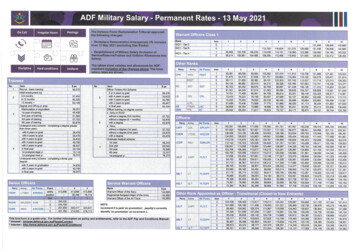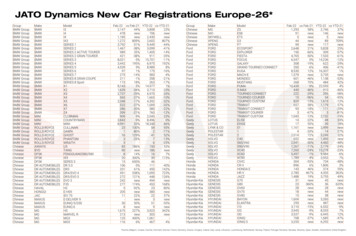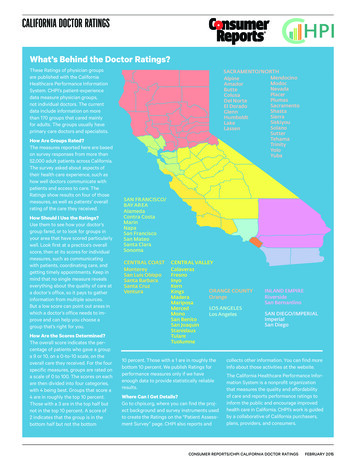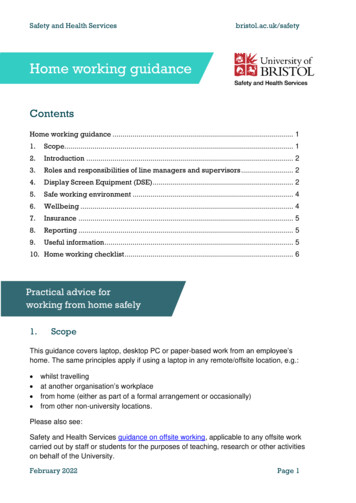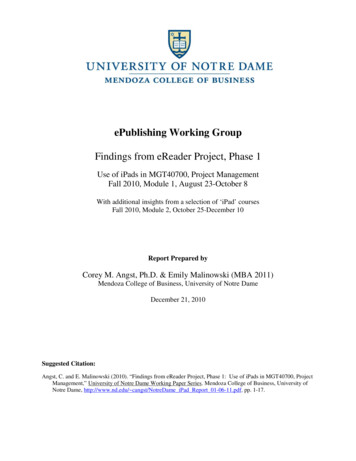
Transcription
ePublishing Working GroupFindings from eReader Project, Phase 1Use of iPads in MGT40700, Project ManagementFall 2010, Module 1, August 23-October 8With additional insights from a selection of ‘iPad’ coursesFall 2010, Module 2, October 25-December 10Report Prepared byCorey M. Angst, Ph.D. & Emily Malinowski (MBA 2011)Mendoza College of Business, University of Notre DameDecember 21, 2010Suggested Citation:Angst, C. and E. Malinowski (2010). “Findings from eReader Project, Phase 1: Use of iPads in MGT40700, ProjectManagement,” University of Notre Dame Working Paper Series. Mendoza College of Business, University ofNotre Dame, http://www.nd.edu/ cangst/NotreDame iPad Report 01-06-11.pdf, pp. 1-17.
ABSTRACTThe eReader Project, launched in the fall of 2010 by the Notre Dame ePublishing WorkingGroup, was initiated with the intent of gaining insight into how Notre Dame could build anecosystem to support the creation, distribution, and consumption of ePubs and eBooks on bothpresent and future eReader devices. The first phase of the research project described heremeasured technology acceptance (ease of use, usefulness, etc.), technology value, and actual useof the iPad devices. The majority of this document describes findings from surveys, focusgroups, and interviews of 40 students in an undergraduate Project Management course during thefirst half of the fall semester; however, we report some empirical comparisons between these 40students and a second wave of 38 students who received the iPads in the second half of the fallsemester. A related goal of this project was to conduct a real-world implementation of eReadersto identify unknown barriers, be they technical or behavioral. Considering our small samplesize, we caution against generalizations or interpreting our findings as policy recommendations;however, our preliminary results suggest several interesting insights. First, our findings suggestthe greatest value of the iPad may not be its ability to function as an eBook reader but instead itscapacity to function as a consolidator or aggregator of information. Second, a statisticallysignificant proportion of students felt the iPad, 1) makes class more interesting, 2) encouragesexploration of additional topics, 3) provides functions/tools not possible with a textbook, and 4)helps students more effectively manage their time. While there were some technical andbehavioral challenges associated with reading the eBook, overall impressions of the iPads werevery favorable and students noted they would tolerate some of the shortcomings as technicalimprovements are being made. Because our results do not provide a comprehensive measure ofthe objectives related to consolidating/aggregating information, nor do they fully explore theextent to which learning outcomes vary with respect to iPad use, further studies that includenatural observation, surveys, and student focus groups are recommended.Page 2
INTRODUCTIONAs technology continues to advance at a rapid pace, our society is becoming increasinglydigitized. This digital transformation has implications for higher education, and has the potentialto change the way professors teach, how students learn, and the manner in which both partiesinteract with course material. Given the daily contact that institutions of higher education havewith one of the largest demographics of new technology adopters (i.e. college students), collegesand universities are uniquely positioned to become partners in innovation for education. Inaddition, the increasing prevalence of technology in both academic and corporate settingsnecessitates that students become comfortable using technology to facilitate learning andproductivity. The purpose of the eReader project is to evaluate the creation, distribution,consumption and usefulness of electronic course materials in an academic setting by examiningthe usefulness of the iPad as an eReader. Through natural observation and a series of surveysand focus groups, the ultimate goal of this study is to design an “ePublishing ecosystem” to servefaculty, students and staff by streamlining the creation, distribution, sharing, reading andannotation of eMaterials in a cost-effective manner. To that end, we provided iPads (seeAppendix for distribution details) to all students enrolled in an undergraduate businessmanagement course (see details below in Methods) with very few directives issued relative tohow to use (or not use) the iPads. We did this because we wanted to understand how or if theiPad changed the way students read, studied, participated, took notes, etc. We also anticipatedthat students would 'invent' ways of using the iPad to improve their course engagement.In the next sections we primarily discuss findings from surveys conducted in the undergraduatebusiness management course. That course was 7-weeks in length, ending just before fall break.After fall break, a new group of students were provided with the iPads. At the time of thiswriting, three surveys had been completed by the second wave of students. Where relevant wehave provided comparisons between the business management students and the second wave ofiPad students, which included a subset of graduate business students.Page 3
METHODSThere were 40 subjects in this study, all of whom were juniors (2) or seniors (38) at theUniversity of Notre Dame and enrolled in Professor Corey Angst’s Project Management course.The course spanned seven weeks (a module), and students were informed after they registeredthat iPads would be distributed to all enrollees with the intention that an eBook would bedownloaded to the device in lieu of the physical textbook typically required. The content of theeBook was identical to that of the physical book, and students were given the option to declineuse of the iPad for the module and purchase a physical textbook. Student response to this optionunanimously favored use of the iPad, and not a single student opted not to participate in theeReader Project study.Online surveys were administered to the students one week prior to the first day of class beforestudents were given the iPads (pretest), at the ends of week 2 and 7, and a post-course surveywas administered three weeks after the iPads were returned. Surveys 1, 2, and 3 were comprisedof identical content and were intended to measure five main effects: Behavioral Intention is simply whether or not the subject intends to use the iPad in thefuture (BI is not reported in survey 3 because the students were returning the iPads).Performance expectancy (usefulness) is defined as the degree to which an individualbelieves that using the system will help him or her to attain gains in performance.Effort expectancy (ease of use) is defined as the degree of ease associated with the use ofthe system.Social influence is defined as the degree to which an individual perceives it importantthat others believe he or she should use the new system.Facilitating conditions are defined as the degree to which an individual believes that anorganizational and technical infrastructure exists to support use of the system.The fourth survey included Performance Expectancy and Effort Expectancy and was primarilydesigned to assess attitudes and beliefs about the use of the iPad after the students had beenwithout it for two weeks.Page 4
RESULTSResults of the main effects observed throughout the four surveys are outlined below. In themajority of studies involving participants’ interaction with new technology, a drop in technologyacceptance and perceived value of the technology are generally observed after initial excitementhas subsided. No such lulls in acceptance or value were detected in the iPad study, as evidencedby the consistent values of Effort Expectancy and Performance Expectancy over time. We didnot collect data on Behavioral Intentions in survey 3 or 4 because the iPads were being takenaway just after survey 3. We also did not believe Facilitating Conditions or Social Influencewere relevant after the iPads were returned and therefore did not collect that data in survey 4.Survey Results over TimeOnly Project Management Students n 40BehavioralIntentionFacilitatingConditionsSurvey 1Survey 2Social InfluenceSurvey 3EffortExpectancy(Ease of Use)PerformanceExpectancy(Usefulness)Survey 41.002.00Strongly DisagreeTakeaways:3.00-4.00to5.00-6.007.00Strongly Agree1. Expectations were high due to the incredible hype surrounding the release ofthe iPad, but performance appeared to live up to the hype.2. Usefulness (PE) was very consistent throughout the entire study and it did not“wear off” even after the iPads were returned, suggesting this was not atransient effect that went away when students went back to the ‘traditional’way of working.Page 5
In the next section of this report, we provide several graphs and brief interpretations of theresults if warranted.How would you rate your skill level of using the iPad?Number of students2520Survey 2Survey 3151050NoneTakeaways:Very littleSomeQuiteextensiveVeryextensive1. After 2 weeks of use (survey 2), students were already quite adept in using theiPads and only 3 students felt they had very little or no skill.2. After 7 weeks of use (survey 3), skill level increased significantly and only 1person felt s/he had very little skill.What percentage of the READING you do for is done using the iPad?25Number of Students20None151-30%30-60%1060-90%90-99%5100%0PM course(after 2 wks)Takeaways:PM course Other course Other course Non-course (2 Non-course (7(after 7 wks)(2 wks)(7 wks)wks)wks)1. Number of students doing 100% of reading in PM class on iPad increasedslightly over time, but generally the results were stable.2. Most students are using the iPad to read at least some material for othercourses and non-courses.Page 6
If you were to take another course from Prof. Angst, which option would you choose?30Number of Students25201510501st Choice2nd3rd4th5thI would prefer a 'loaner' iPad and I would purchase the eBook for 50. The eBook would expire after 6 months.I would prefer to purchase an iPad for 499 that I would own and I would purchase the eBook for 50. The eBook would expire after 6 months.I would prefer to purchase an iPad for 499 that I would own and I would purchase the eBook for 75. The eBook would never expire.I would prefer to buy a paper-based textbook for 100I would prefer to RENT a paper-based textbook for 40, even though I can't highlight it.**I was informed after the survey was administered that the ND book rental policy allows students to highlight thetextbook. This may have skewed our results in an unfavorable way relative to that option.Takeaways:1. Students preferred the iPad loaner model in which the book expires.2. 35 students chose the iPad loaner model as their 1st or 2nd choice followed by‘textbook rental’ with 21 students.To what extent do you agree/disagree with the following statements?Number of Students2520Strongly DisagreeMean: 3.453.70Disagree3.75Neutral3.35Agree3.20Strongly Agree4.183.25151050Using the iPad I can learn more inI think I amThe iPad lacksThe iPad helps me The iPad providesThe iPadmakes projectany class by usinglearning moreimportantmore effectivelyfunctions/toolsencouragesthe iPadabout project management morefunctions/toolsmanage/conductthat are notexploration ofinterestingour projectpossible with a that are available management as aadditional projectwith a traditional result of using thetraditionalmanagementiPadtextbook or othertextbook ortopicsdeviceanother devicePage 7
Takeaways:1. The perceptions of the students are that the iPad encourages exploration,allows them to more effectively manage the project, provides additionalfunctions but also lacks important functions, and makes project managementmore interesting.2. Even in this admittedly small sample of 40 students, the means of all but items5 and 7 differ significantly from the neutral response.3. While not statistically significant, the majority of students said they arelearning more by using the iPad.What are your general feelings about using the iPad in this PM course?Number of students252015Strongly DisagreeDisagreeNeither Agree nor DisagreeAgreeStrongly Agree1050I loved using the iPad and would prefer I was frustrated with some things theto use it in all my classes going forward iPad could not do but I am willing towait for improvements.Takeaways:1. This result demonstrates some of the dissonance in beliefs about the iPad.2. While a large proportion of students would like to use the iPad in all classes,there was still significant frustration with some of the limitations, yet studentsappear willing to wait for improvements.Page 8
How difficult is it going to be to give up your iPad?Easy"very easy,easy, andsomewhatdifficult"NeutralPage 9
Takeaways:1. Those who reported difficulty (ranging from “very difficult” to “somewhatdifficult”) in giving up the iPad seemed to use the iPad more frequently as analternative to a laptop or mobile device. While the iPad was not foreseen asbeing a substitute for a laptop or Smartphone, those who reported the mostdifficulty in returning the device seemed to use it as such.2. Those for whom it was easy (ranging from “somewhat easy” to “very easy”)to return the device did not rely heavily on the device throughout the study.They continued to use the technology they were accustomed to, such as alaptop and/or iPhone.Comparisons across CoursesAfter the 7-week project management course ended, the iPads were redistributed to students inthree different undergraduate courses and a small group of MBA students. We include thissection of the report not as an exhaustive research inquiry but more so to provide somecomparisons across course and academic levels. Descriptions of the courses and students areModule 2 (2nd 7-week session)Module 1supplied in the table below.CourseNumberCourse NameCourse DescriptionNo. Students andAcademic ion to the process ofmanaging projects2 juniors38 seniorsFYS10402Law School 101FYS10107AL 23200MBA(variety)Contemplation andthe First YearExperienceResearch Strategiesfor theInformation AgeFirst Year Studies: Intro tothe law school experience forstudents considering lawFirst Year Studies:Introduction to collegiatethinkingArts and Letters:Intro to resources for studentsinterested in researchMasters in BusinessAdministrationEach student had multiplecoursesTotals across Modules 1 and 2Page 1015 freshmen2 sophomores1 junior7 freshmen2 freshmen3 sophomores1 senior7 studentsall in 1-year MBAprogram24 freshmen5 sophomores3 juniors39 seniors7 graduate students78 total students
In this section of the report, we provide several graphs depicting comparisons across courses.Each of the participating undergraduate courses in module 2 was taught by a different professorwho ‘self-selected’ to use the iPads in his/her course. The MBA students volunteered toparticipate and their professors were not made aware that the students were participating in thisresearch. No students in our sample participated in more than one “iPad” course.Behavioral Perceptions across Courses over Time(Survey 1-pretest and Survey 2-after 2 weeks)Strongly Disagree to Strongly y2SNSurvey1SNSurvey2Behavioral PerceptionsTakeaways:1. Perceptions were very consistent across undergraduate courses, suggestingthat the course itself and/or professor may not be predictive of the overallsuccess of the program, however, it is important to note that each of theprofessors self-selected to use the iPads so this could introduce some bias inperceptions by the students.2. On average, undergraduate participants perceived the iPad device to be over17% more useful (PE) in attaining performance gains than did graduatestudents.3. Graduate student perceptions of usefulness declined slightly after using thedevice, while undergraduate perceptions of usefulness remained steady orincreased on average between surveys 1 and 2. It is possible that MBAusefulness declined because there use was entirely self-directed with none oftheir professors leading or participating in the iPad initiatives.Page 11
Specifically related to the articles/chapters that are available on your iPad, how frequentlydo you print the readings?80%NeverAlmost NeverSometimesAlmost AlwaysAlways70%% of Students60%50%40%30%20%10%0%FYS10402Law School 101Takeaways:FYS10107AL 23200MGT40700Contemplation & the Research Strategies for Project ManagementFirst Year Experience the Information AgeMBAMasters in BusinessAdministration1. More than 70% of the students NEVER or ALMOST NEVER printed materialbut there was some variation across courses.2. Using the iPads does not appear to significantly increase printingStrongly Disagree to Strongly AgreeWhat type of courses would be appropriate for eReader/eTextbooks?5.0FYS10402 Law101FYS10107 First Year Exp.AL 23200 Research StrategiesMGT40700 Proj MgtMBA4.54.03.53.02.52.01.51.0Classic ype of Course Appropriate for iPad UseBiology1. The more technical courses appear to be less viable options for eReaders. Butour student sample did not include students in the math/sciences disciplines.2. From our focus groups we learned the Classic Books class generally ratedlower because a) students felt they needed to really ‘study’ the books, b) thebooks are usually easier to carry and hold, and c) there was gratification inbeing seen in public with a “thick novel,” i.e. makes them look smart.Page 12
Strongly Disagree to Strongly AgreeTo what extent do you agree/disagree with the following 01073.33.3AL 23200MGT407003.0MBA2.5Overall Mean2.01.51.0The iPad helpsUsing the iPad I can learn moreThe iPadThe iPadThe iPad lacksI think I amme moremakes thisin any class byencouragesprovidesimportantlearning moreeffectivelycourse more using the iPadexploration offunctions/tools functions/toolsabout thismanage myinterestingadditionalthat are notthat arecourse as atimecourse topicspossible with a available with a result of usingtraditionaltraditionalthe iPadtextbook ortextbook oranother device other deviceTakeaways:1. The value 3.0 is a ‘neutral’ response, therefore the graph shows that in allquestions the Overall Mean is statistically greater than 3.0 (pooled sample sizeof 77). This suggests that on average, students feel the iPad; a) encouragesexploration of additional course topics, b) helps manage time, c) provides newfunctions/tools, d) increases learning, and e) makes courses more interesting.2. It is also true that the iPad LACKS important functions/tools that are availablewith a traditional textbook.Counts and ValuesWith this question, we attempted to capture an ‘extent of use’ variable. We asked thestudents to go to the Settings General About menu on their iPads and enter the valuesassociated with the number of Songs, Pictures, Applications, and GB (gigabytes) available.120100806040200FYS1040254.8FYS10107AL 2320020.310.8MGT40700MBASongs x10Takeaways:70.1PhotosAppsGB availableOverall Mean1. Type of usage varied considerably across courses.2. We found a correlation of .333 (p .01) between the variables “I loved usingthe iPad and would prefer to use in all my courses” and “Number of Apps.”We did not find statistical relationships between other perceptions of the iPadand actual usage. Interestingly, this might suggest that students weren’t justsaying they loved the iPad because of its ability to store music and pictures butinstead that the Apps were what made it valuable as an academic tool. It alsocould be that the Apps being downloaded are games instead of academic toolsin which case the interpretation is unclear.Page 13
What percentage of the READING you do for is done using the iPad?6100%FYS10402FYS10107AL 23200MGT40700MBAOverall Mean590-99%460-90%30-60%31-30%2None1This CourseOther CoursesNon-Course*MBA students did not have a specific course directed toward the iPadTakeaways:1. A significant proportion of the reading in the primary course was done usingthe iPad. Of the reading that was not done using the iPad, we do not know if itwas available on the iPad.2. A considerable amount of non-course-related reading was done using the iPad.CONCLUSIONOur research is not comprehensive, yet it provides a strong foundation for future study and offersseveral key insights as outlined in the Takeaways above. Additional research should includenatural observation, surveys, and student focus groups to further explore questions related tolearning outcomes, types of use, and benefits beyond that of eReading which could contribute tolearning. No major technical challenges with the devices were found and the distribution andretrieval processes were streamlined and efficient. All iPads have been returned in a timelyfashion with no signs of misuse, which may be partially due to the fact that the students wererequired to keep their iPads in the Apple iPad Case. During the course of our study, one iPadwas stolen from a locked car (the iPad was in a backpack and not visible) and two tech-supportcalls were received in Module 1 and two in Module 2.It is the opinion of these researchers that it is premature to make a decision about widespreaddistribution of iPads or any eReaders. We are using the term ‘distribution’ to mean requiringstudents to adopt an iPad. The intent of this initiative was not to investigate, suggest, or endorsea specific means of funding the initiative, e.g. computing fee, University funded, course-specificfee, etc. While it appears perceptions of value are high amongst students, the technology is notyet mature as it specifically relates to the eTextbook. Highlighting and annotating arePage 14
cumbersome but improvements are being made rapidly. In addition, the cost of the devices( 499 for the model we used) appears to be prohibitive for students, even considering thateTextbooks are usually 60-80% of the cost of a traditional textbook. Even if the technologywere mature, with new competitive offerings coming to the market rapidly, it is unclear whichdevice would be optimal for distribution.What we can say is that in some courses, most students see value in using an iPad. In particular,we found it striking that on average, students feel the iPad; a) encourages exploration ofadditional course topics, b) helps manage time, c) provides new functions/tools, d) increaseslearning, and e) makes courses more interesting. These are potentially important findings worthyof further investigation. Our preliminary investigation suggests that many book titles are nowaccessible using iPads. We also note that there appears to be no reason why students could notadopt an eTextbook, even if it is not assigned by a professor. Technical support is available forstudents and faculty if either choose to adopt an eTextbook and our study did not reveal anynegative outcomes.ACKNOWLEDGEMENTSWe wish to acknowledge two people from Academic Technologies, Paul Turner and JonCrutchfield, who have been invaluable to our pilot project.Page 15
APPENDIXOPEN ENDED COMMENTS from STUDENTSWhat benefits do you see from using iPad? Not having to carry around a textbook, better communication amongst the team, sharedinformationIt's very convenient to carry around plus it makes you look tech savyI think staying up to date on the most current technology is extremely important in this fast pacedworld.If more classes adopted the ability to use this i probably wouldn't be carrying a backpack at all.It is obviously helping avoid unnecessary paper waste, but it also opens up a lot of possiblecollaboration that didn't exist with the normal textbook set up. That is assuming that the softwarecontinues to progress at a rapid pace.Instant information at your fingertips.I am more organized and my backpack is certainly lighter since I dont need to carry my laptopand cord everywhere. I also LOVE the long battery life.I carry it in my backpack instead of a heavy backpack and it is easy and fast to surf the net.I have a PC so using the iPad has helped me get used to Macs more.SUMMARY of FOCUS GROUPSPros and Cons of the iPad:Summary of Focus Group DiscussionsCons:Pros:PortabilityAnnotated highlighting – not quite thereConsolidation – everything in one placeBattery lifeTaking notes on device (whether typed or handwritten) is very difficultVersatility – phone (Skype), text, emailHelpful more for business – not so much classroomConnectednessUncomfortable with the fact that there is no “save”buttonEmail much easier on iPadCalendar on iPad more effective than on iPhoneGreat for gamesUnable to multi-task when using device -- cannot havetwo windows opened side by sideWhen using a textbook, difficult to flip back and forthbetween pagesGlossy screen of device creates glare*Recurring Theme: The ancillary benefits of the iPad (consolidation of personal/school lives,constant connectedness, etc.) outweigh the device’s drawbacks as an academic tool.Page 16
DISTRIBUTION of IPADS*See wiki https://wiki.nd.edu/display/oitepublishing/iPad Configuration for Pilot. It alsoincludes an Enterprise Deployment Guide.TrainingFor future course implementations, we would recommend a short tutorial on usage - notspecifically on how to use the iPad but instead on some specific applications.Page 17
Use of iPads in MGT40700, Project Management . Fall 2010, Module 1, August 23-October 8 . With additional insights from a selection of 'iPad' courses . Fall 2010, Module 2, October 25-December 10 . Report Prepared by . Corey M. Angst, Ph.D. & Emily Malinowski (MBA 2011) Mendoza College of Business, University of Notre Dame . December 21, 2010



